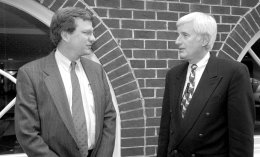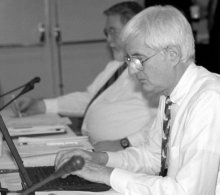 |
|
HEPAP Unveils 20-Year Plan for U.S. High Energy Physics by Judy Jackson
On an unusually balmy winter day in Washington late last month, the High Energy Physics Advisory Panel officially launched the plan that they hope will lead to a new era of opportunity for particle physics in the United States. Among its recommendations, the “Report of the Subpanel on the Long-Range Future of U.S. High-Energy Physics” calls for creating a system for prioritizing particle physics projects and, eventually, for building a new international particle accelerator “somewhere in the world”—preferably somewhere nearby.
The new plan is the product of a 22-member HEPAP Subpanel, charged by the Department of Energy and the National Science Foundation with the daunting task of consulting with the U.S. particle physics community to produce a plan for the future of a field that, in recent years, has been hard pressed to maintain its leading edge. Straitened federal funding for U.S. particle physics, and indeed for all of the physical sciences, has left cash-strapped physicists struggling to maintain momentum in a science where Americans have traditionally led the field. The Subpanel’s report represents, if not a consensus on the best way forward, at least as close to consensus as they are likely to get in a community where strongly held opinions are as divergent as particles in a high-energy collision. The Subpanel, chaired by physicists Jonathan Bagger, of The Johns Hopkins University, and Barry Barish, of Caltech, listened to hundreds of U.S. particle physicists from across the nation, as well as foreign colleagues, before presenting the draft of their report to HEPAP on October 29, 2001.
“We kept the process as open and interactive as we possibly could,” Barish said. “We set up a website, held open meetings and even shared a set of questions with the community. We invited input in the form of letters or face-to-face conversations with the Subpanel. The response was overwhelming! We received about 100 letters, we had many talks with our colleagues, and we heard reports from Snowmass working groups. We could not hope to satisfy all of the diverse opinions that we heard, but they were very influential in determining our recommendations.”
Not all U.S. physicists had endorsed the initial October 29 draft with such unanimity, however. In particular, members of Fermilab’s BTeV collaboration interpreted its recommendations to mean the demise of their 4-year effort to bring to reality their proposal to study the physics of the B meson at Fermilab’s Tevatron. But changes to the draft left BTeV collaborators at least cautiously satisfied with the final plan. In remarks delivered at the meeting, co-spokesman Joel Butler spoke for the BTeV collaboration.
“After the October 29 release of the draft report,” Butler said, “there were several developments. The subpanel chairs, Jon and Barry, assured us that the subpanel did not intend that BTeV be killed, explained to us what they did mean, and said that they would change the words to make their intent more clear.”
"High Energy Physics is entering an extraordinary period of discovery"
The clarification process, while painful, Butler said, brought out the best in the tradition of vigorous discourse in the field.
“I want to comment on the process we have all just been through,” he said. “It has been difficult, sometimes tense, frequently vocal, and quite public. In its odd way, however, it has accomplished much…. It has, in my judgment, led to a better report for those who are concerned about the diversity in the field, especially in the neutrino and heavy quark sectors of our community. This kind of discourse requires much patience and mutual good will and respect and is in our best tradition.”
While discourse within the field may be flourishing, particle physicists recognize that they have just begun the discourse with the rest of the world that will determine whether the new plan leads to anything resembling reality. For starters, particle physicists face a difficult task in communicating the revolutionary potential of a field often viewed as either impossibly esoteric or devoted merely to ever-more-refined riffs on the Standard Model of particle interactions, the reigning theory of the structure of matter. In transmitting the plan to the funding agencies, Gilman focused on the scientific opportunities now emerging for the field of particle physics.
“High-energy physics is entering an extraordinary period of discovery,” Gilman said. “Are there extra dimensions of space? What is the dark matter that makes up the majority of our universe? What unknown mechanism gives mass to particles? Solving these mysteries will be an epochal chapter in the history of science. Physicists now have within reach the technology and understanding to find the answers.”
That technology doesn’t come cheap, however. In a field where the price tags of the tools of the trade quickly mount into the billions of dollars, particle physicists must make clear not only the compelling nature of the discoveries they seek, but also their willingness to choose the best of the best experiments among the many paths to discovery. To this end, the Subpanel recommends something new for high-energy physics, a formal continuing mechanism for setting priorities. It proposes the creation of a Particle Physics Project Prioritization Panel, dubbed “P5,” to assess and prioritize proposed experiments and other research initiatives to ensure the highest scientific return on public funding for particle physics. The report does not spell out the exact makeup and functioning of P5, a question that is likely to form the subject of ongoing discussion over coming months.
At the heart of the report, and what makes it more than a mere exercise in prioritization, is the recommendation that a high-energy, high-luminosity, linear particle accelerator should be designed, built and operated as a fully international collaboration, somewhere, sometime soon.
“The world particle physics community agrees that a linear collider is the right choice for the next major physics facility,” Barish said recently. “There are initial proposals to build such a collider in Germany, Japan and in the United States. Although there are many steps to be taken to decide design, funding and collaboration issues before such a project can go forward, our sub-panel strongly recommends that U.S. scientists participate in this initiative wherever it is built.”
The panel then takes a step further and recommends that the United States “prepare to bid to host” the initiative.
Bagger enunciated the benefits of building the world’s next accelerator on the home turf.
“Building the linear collider would bring one of the great scientific projects of our time to the United States,” Bagger said, “together with its associated intellectual, educational, technological and economic benefits.”
The panel estimates that the cost of constructing the 30-km (18-mile) long collider in the United States would be $5 to $7 billion, with one-third of the financing coming from international contributions and a further $1 to $2 billion from realignment in the current U.S. particle physics program.
Although reluctant to predict exactly when the new accelerator might be built, the Subpanel proposed that a steering group be set up immediately to coordinate U.S. participation in a linear collider. Much subsequent discussion at the meeting centered around the makeup and responsibilities of the Linear Collider Steering Committee.
Besides the linear collider, the new HEPAP roadmap reflects the need for a variety of techniques and experimental approaches to achieve scientific goals, physicists familiar with the plan said.
“Particle physics requires forefront accelerators at the energy and luminosity frontiers,” said University of Oregon physicist Jim Brau, an experimenter at the Stanford Linear Accelerator Center, in a prepared statement. “However, the plan also recognizes the need for innovative experiments in space and deep underground. A balanced approach that strengthens the increasingly important links to astrophysics, cosmology and nuclear physics is the foundation for a future of scientific discovery in our field.”
The HEPAP report presents a focused way forward for U.S. particle physics, members of the Subpanel said. They emphasized that its recommendations are long term, underlining the need for careful coordination and planning in a field characterized by global partnerships and in which most experiments begin taking data years after they were originally conceived.
Officials from both DOE and NSF thanked the Subpanel for their efforts but largely refrained from comment on the report itself, noting that they were only now receiving the plan. Acting DOE Office of Science Director James Decker did say that the Department would take the report “very, very seriously.” At a meeting of the Universities Research Association’s Council of Presidents two days later, DOE Under Secretary Robert Card called the linear collider “an interesting project,” but said its future would depend on physicists’ success in making the case for its scientific value to the country.
“Responding to this plan will take resources, creativity and determination, together with the commitment of the American people and the government.” Gilman wrote. “But this is not the time to shy away from challenges, especially when the benefits from success are clear. By making a renewed commitment to our scientific and technical base, we will be repaid by strengthened international cooperation and a new level of U.S. leadership and achievement in science and technology, together with the benefits that flow from them.”
The Report of the DOE/NSF High-Energy Physics Advisory Panel Subpanel on Long Range Planning for U.S. High-Energy Physics, and the accompanying letter from HEPAP Chair Fred Gilman, are available online
|
 At the January 30 HEPAP meeting, held at Georgetown’s Latham Hotel, HEPAP Chair Fred Gilman, of Carnegie Mellon University, called for a vote of acceptance from the panel before transmitting the Subpanel’s report to DOE and NSF, the federal agencies that fund high-energy physics in the United States. The "ayes" had it, unanimously.
At the January 30 HEPAP meeting, held at Georgetown’s Latham Hotel, HEPAP Chair Fred Gilman, of Carnegie Mellon University, called for a vote of acceptance from the panel before transmitting the Subpanel’s report to DOE and NSF, the federal agencies that fund high-energy physics in the United States. The "ayes" had it, unanimously.
 In an accompanying letter to DOE and NSF, HEPAP Chair Gilman stressed the importance of basic science for national security and economic strength, but acknowledged the stiff challenges that particle physicists will face in carrying out their plan at a time when national resources are focused on the struggle against global terrorism, and the national economy is faltering.
In an accompanying letter to DOE and NSF, HEPAP Chair Gilman stressed the importance of basic science for national security and economic strength, but acknowledged the stiff challenges that particle physicists will face in carrying out their plan at a time when national resources are focused on the struggle against global terrorism, and the national economy is faltering.